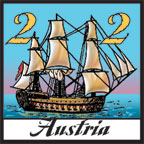| The
Kaiser’s Fleet
By Mike Bennighof, Ph.D.
May 2021
 Austria entered the Napoleonic Wars with
a navy consisting of two gunboats, one based
at Trieste and the other at Fiume. Charged
with enforcing customs regulations, the tiny
navy had no role in the empire’s military
plans and was not even mobilized until March
1797. Austria entered the Napoleonic Wars with
a navy consisting of two gunboats, one based
at Trieste and the other at Fiume. Charged
with enforcing customs regulations, the tiny
navy had no role in the empire’s military
plans and was not even mobilized until March
1797.
Austria’s flirtation with sea power
began in 1382, when Duke Leopold III of Austria
undertook to protect the port city of Trieste
from Venice, but for the next several centuries
the Habsburg Empire did not make an effort
to build naval power.
Things began to change in October 1797 when
the Treaty of Campoformio assigned Venice
to Austria. Along with the proud city came
what was left of its navy: ten 74-gun ships
of the line, seven frigates, and a large number
of galleys. The best ships and most equipment
and materials had been taken from Venice’s
Arsenal for the French Navy’s use.
Typically overwrought Habsburg bureaucracy
resulted in two naval establishments claiming
jurisdiction over the ships: the “Trieste
Navy,” consisting of the two gunboats
and commanded by Col. James Ernest von Williams,
and the “Venice Navy” commanded
by Venetian aristocrat Andrea Querini but
holding authority only over the Arsenal. Both
commanders recommended that the four frigates
and two smaller warships found undamaged be
overhauled and manned to protect Austrian
trade in the Adriatic and Mediterranean, then
suffering costly raids by North African corsairs.
The Austrian finance ministry refused to fund
the effort, and made things worse by discontinuing
the Venetian Republic’s payments of
bribes to the Barbary pirates.
The ships of the line found in the Arsenal
could not be made ready for sea until the
channels outside the shipyard had been deepened.
Worse, the French had knocked the stocks out
from under them before leaving, and most had
been heavily damaged when they crashed onto
their sides. Austria acquired three more in
a complete state of readiness when Ancona
fell to a combined Austrian-Russian force
in 1799 and Austrian officers sneaked aboard
to raise the red-white-red naval ensign over
all the vessels in the harbor before the Russians
could take possession. The act helped cost
the Habsburgs their alliance with Russia,
and after a naval parade to Venice the ships
were left to rot. Stengel, Beyrand and Laharpe, former Venetian ships in French
service, were eventually broken up and their
timbers sold for firewood.
Not until 1801 did Austria begin to make
use of the former Venetian warships, when
Archduke Charles took office as “War
and Navy Minister” and for the first
time the fleet had a powerful patron in Vienna.
Charlkes authorized a fleet of eight frigates,
tasked with protecting Austrian trade as far
south as Malta, and appointed emigre French
royalist officers to command them. Funding
shortfalls kept the squadron at three frigates,
a corvette and four brigs, but they began
to operate against French privateers and North
African corsairs. A squadron of two brigs
sailed to the Moroccan coast in a vain attempt
to intimidate the Sultan into stopping attacks
on Austrian shipping.

The Arsenal of Venice, as seen in 1850.
|
When war returned in 1805, the tiny Austrian
navy could not man all of its ships and only
the corvette and two brigs put to sea. France
defeated Austria decisively at Ulm and at
Austerlitz, forcing the empire to hand over
all its former Venetian territory plus all
former Venetian warships in Austrian service.
Reduced to three brigs, the Austrian squadron
moved to Senj, a longtime base for Croatian
pirates.
Austrian troops boarded four Russian ships
of the line interned at Trieste in 1807, but
Austria made no move to man the vessels.When war returned again in 1809, the tiny
Austrian fleet received direct orders not
to challenge the far more powerful French.
The brig Delphino, ignoring these instructions,
captured a French gunboat to give Austria
a naval victory in its only sea battle of
the Napoleonic wars.
The Treaty of Schonbrünn handed
all of Austria’s coastal lands to the
French, temporarily making Austria a land-locked
country and ending the need for a navy. British
warships seized the four remaining brigs and British
crews took them to Malta, where they were
sold at auction with the cash received sent
to Vienna.
Emperor Franz at first released the navy’s
small officer corps from their oaths of allegiance,
considered a deadly insult by many. Relenting,
the emperor allowed them to transfer to the
army and most ended up with the Danube gunboat
flotilla. For the next several years the navy
ceased to exist, but in November 1813 Austrian
troops re-enetred Trieste and armed four small
gunboats to re-inaugurate the Austrian Navy.
Unlike Trieste, Venice held out for seven
months under siege and only yielded to the
Austrians when Napoleon’s Italian viceroy,
Eugene de Beauharnais, signed an armistice
in April 1814. The agreement specified that
all ships, fortifications and naval stores
had to be turned over intact, and French Vice
Admiral Guy Duperré kept his word.
Ten ships of the line (four complete and six
still under construction), eight frigates
(three complete, five under construction)
and a number of smaller vessels fell into
Austrian hands. Officers and crews proved
harder to find, as Franz snubbed those who
had served Napoleon even though the 1805 peace
treaty had required Venetians to transfer
to Italian service and Franz had released
the remainder from their oaths in 1809.
 The
three complete frigates would eventually sail
under Austrian colors, as Austria, Augusta and Caroline. Only one of the ships of the
line ever saw Austrian service, as the fleet
commander’s stationary flagship anchored
in Venice’s lagoon; two of the others
would sail after they had been cut down to
frigates. Austria tried to sell the remainder
to a variety of nations including the United
States and the Pope. The only serious offer,
a Danish trade of 3,000 cavalry mounts for
three ships of the line and a frigate, fell
through when the king of Denmark backed out
of the deal. Austria continued to try to sell
her ships, but one by one they fell prey to
fire and rot. The
three complete frigates would eventually sail
under Austrian colors, as Austria, Augusta and Caroline. Only one of the ships of the
line ever saw Austrian service, as the fleet
commander’s stationary flagship anchored
in Venice’s lagoon; two of the others
would sail after they had been cut down to
frigates. Austria tried to sell the remainder
to a variety of nations including the United
States and the Pope. The only serious offer,
a Danish trade of 3,000 cavalry mounts for
three ships of the line and a frigate, fell
through when the king of Denmark backed out
of the deal. Austria continued to try to sell
her ships, but one by one they fell prey to
fire and rot.
In our Soldier
Emperor game Austria has one weak
fleet, which is never available at the start
of a scenario. We gave it no special rules
because that seemed useless for a piece that
rarely enters play, but Daily Content variants
are under no such constraints.
The Austrian fleet can only be placed at
Venezia, and can only be constructed if the
Austrian player controls both Venezia and
Croatia. If Venezia has never been conquered
by another power, Austria can construct two
more fleets under the same restrictions. If
at any time Austria has no coastal areas,
all Austrian fleets are removed from play.
In addition, for both this variant and the Serene
Republic variant fleets built by Austria
or Venice take only three turns to arrive
rather than the usual four, reflecting the
enormous productive capacity of the Arsenal.
You can
download the new Austrian fleet pieces
here.
Click here to order Soldier Emperor!
Sign up for our newsletter right here. Your info will never be sold or transferred; we'll just use it to update you on new games and new offers.
Mike Bennighof is president of Avalanche Press and holds a doctorate in history from Emory University. A Fulbright Scholar and NASA Journalist in Space finalist, he has published far too many books, games and articles on historical subjects.
He lives in Birmingham, Alabama with his wife, three children and his dog, Leopold.
|
